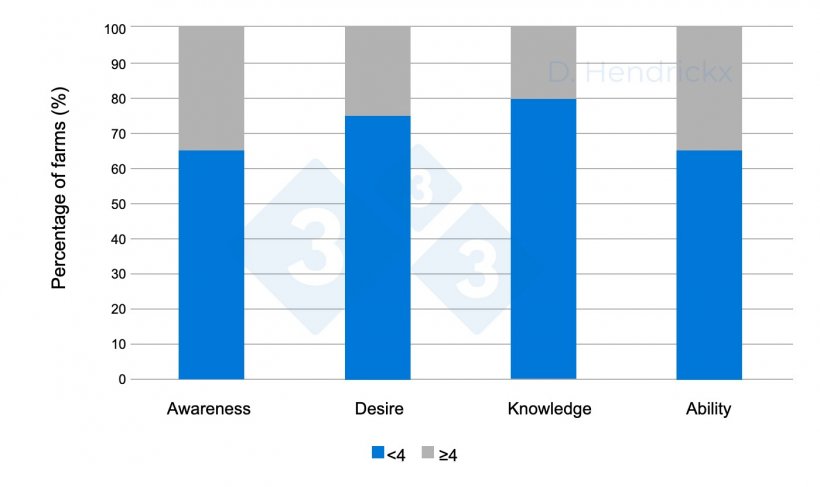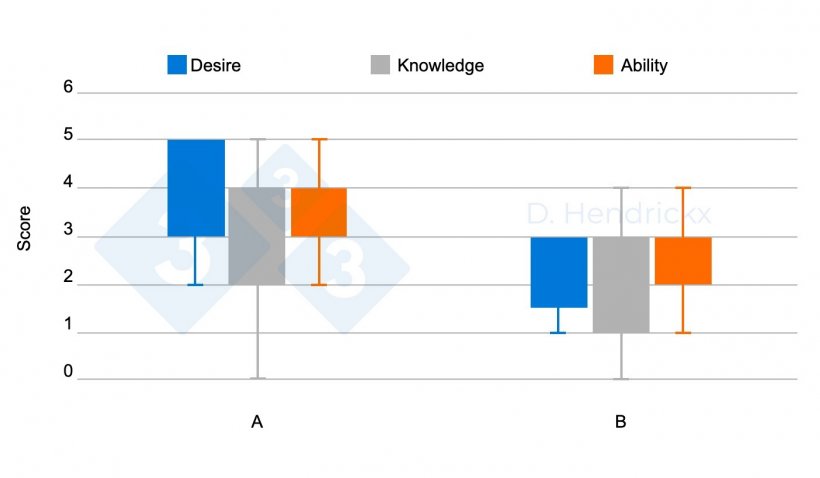What were our objectives?
In the Netherlands, pig farmers, companies, buying groups, and public affairs have teamed up in the Coalition of Vital Pig Husbandry (CoViVa). One major aim is producing Porcine Reproductive and Respiratory Syndrome (PRRS) Wild Type Virus (WTV) free piglets and eventually eradicating PRRS nationwide.
Veterinary practitioners have enough knowledge to eliminate PRRS virus from individual farms and regions. Convincing farmers to eliminate PRRS virus is the hard part.

Our aim was to profile farmers based on their perceptions and willingness towards the eradication of PRRS using the ADKAR Change Management Model.
How did we do this?
The research methodology involves a comprehensive survey and data collection from various farms. The data collected is then analyzed using statistical methods to derive meaningful insights.
The ADKAR model, a well-known change management framework developed by Prosci (The Prosci ADKAR® Model | Prosci), is designed to help individuals and organizations navigate change effectively. The acronym ADKAR stands for:
- Awareness of the need for change
- Desire to participate and support the change.
- Knowledge of how to change.
- Ability to implement desired skills and behaviors.
- Reinforcement to sustain the change.
This model emphasizes that successful organizational change can only happen when individuals change. It provides a structured approach to guide people through the change process, addressing potential roadblocks and ensuring that each step is effectively managed.
By integrating the ADKAR model with PRRS elimination strategies, you can create a structured and effective approach to manage this significant challenge in swine production.
First, we designed a specific PRRS ADKAR scoring table by providing clear definitions for each element (Table 1). Two veterinarians were trained as coaches and carried out all the interviews with each farmer and determined the score for each category in the model.
Table. 1. PRRS ADKAR scoring table.
| Awareness | Represents the awareness that PRRS in swine herds (farmer's own herd, and eventually the whole of the Netherlands) should be eradicated while PRRS is a problem for overall health status in the farm, technical and economical benefits. | 1 | Farmer is not aware of the health and welfare problems that PRRS causes in swine herds, has no idea of the costs in case of a PRRS infection nor the benefits of producing WTV free piglets. |
|---|---|---|---|
| 2 | Farmer is aware of problems that PRRS causes and the economic losses, but states that eradication isn't necessary. | ||
| 3 | Farmer is aware that something has to be done to reduce PRRS infections, but contests the role of PRRS in his own herd. | ||
| 4 | Farmer is aware that PRRS WTV should be eradicated in his herd, and accepts that there are efforts and costs associated. | ||
| 5 | Farmer is fully aware that PRRS should be eradicated in the Netherlands, and that he has to take his responsibility on his farm, including efforts and costs. | ||
| Desire | Represents the personification of the awareness. Is the farmer willing to start an eradication of PRRS in his farm? | 1 | Farmer doesn't want to start an eradication. says there aren't problems with PRRS in his herd. |
| 2 | Farmer wants to be PRRS WTV free and to eradicate, but at the end doesn't want to make costs of efforts what so ever. | ||
| 3 | Farmer wants to have a "PRRS stable herd", he doesn't want problems with PRRS, but eradication is too difficult/expensive. If it's under control with a vaccination it's fine for him. | ||
| 4 | Farmer wants to start eradicating PRRS in his herd, but becomes critical in accepting advice and implementing the measures, measures that are too expensive he won't do. | ||
| 5 | Farmer wants a total eradication in his herd, and wants the best advice and measures for his farm. He accepts that there are considerable costs and efforts related to an eradication. | ||
| Knowledge | Represents the knowledge and craftsmanship of the farmer to start a PRRS eradication in his herd. Knowledge about PRRS eradication is two-fold: (a) status of the herd, In which phase of production does my problem start?, and (b) What do I have to do to solve this problem? | 1 | Farmer doesn't have any idea of his status, nor what he has to do on his farm to begin to produce WTV free piglets. |
| 2 |
Farmer has a little idea of the status of his farm, but no idea where to start in the farm. Farmer doesn't know the status, he has some ideas what he has to change in management. |
||
| 3 |
Farmer has a pretty good idea what the status is, but still no idea which changes to make. Farmer has no idea of status, he knows some things in his farm he has to change. |
||
| 4 | Farmer knows his status. He knows some broad lines where ha ahs to make management changes. | ||
| 5 | Farmer knows his status. He knows what has to be done in his farm to make it possible to produce WTV free piglets. | ||
| Ability | Represents the implementation phase of the change. Is the farmer willing - or already making - to make changes? (Topics for change are external and internal biosecurity including possible renovation of building, management of gilts, working methods, ...) | 1 | Farmer sees only obstacles (costs won't meet the advantages, if my neighbor has PRRS what's the use for me, ...) and therefore doesn't implement any. |
| 2 | Farmer wants to do a limited number of changes which are easy to achieve. He doesn't select changes upon expected effect, but on costs. | ||
| 3 | Some changes are accepted and implemented, he selects changes that are advised by veterinarian as the most important ones. | ||
| 4 | Farmer wants and makes changes as advised, he wants to do them all, but money, time, or cooperation of staff are hampering some changes. | ||
| 5 | Farmer is investing time, money, effort, and guidance of staff to implement all the changes that are advised to produce WTV free piglets. |
Twenty sow farms (1029 average sows, min: 320, max: 4112) were randomly selected from one veterinary practice. All farms were PRRSV positive and vaccinated against PRRSV.
What did we find out?
1) Major differences were observed between farms for the parameters of awareness, desire, knowledge, and farmers' ability for PRRSV eradication.

2) Results indicated that very few farmers were mentally prepared to eliminate PRRSV: only two farms demonstrated a proper mindset (had a score >4 on each element). 10 farms scored below 4 on all elements.

3) Recognizing PRRS as a problem enhances comprehension of other elements. Farms that scored >4 for awareness scored on average higher (3.66, range 2.66 - 4.66) on the other elements than farms that scored <4 (2.34, range 1.66 - 3.5, p=0.004).

4) The ADKA(R)-model aids veterinarians in being more targeted in their advice, allowing them to focus on those element(s) that are critical in a specific farm. It also allows to screen the farmers most likely to implement the needed change for success.
Combining the ADKAR model with strategies for PRRS elimination can be quite effective in managing change within swine herds. Here’s how the ADKAR model can be applied to PRRS elimination:
- Awareness: Educate farm staff about the importance of eliminating PRRS and the impact it has on herd health and productivity. This includes understanding the virus, its transmission, and the economic benefits of eradication.
- Desire: Foster a collective desire among all stakeholders to support the PRRS elimination efforts. This can be achieved by sharing success stories, potential financial gains, and improved animal welfare.
- Knowledge: Provide detailed training on PRRS elimination protocols, such as the Load-Close-Expose method, vaccination strategies, and biosecurity measures. Ensure everyone knows their specific roles and responsibilities.
- Ability: Equip the team with the necessary tools and resources to implement the PRRS elimination strategies. This includes access to vaccines, diagnostic tools, and proper facilities for isolation and biosecurity.
- Reinforcement: Continuously monitor and reinforce the practices to ensure the PRRS elimination efforts are sustained. Regular assessments, feedback sessions, and adjustments to protocols based on outcomes are crucial.
Challenges ahead
Results indicate that to achieve the goals of CoViVa there's some work to do in changing the mindset of Dutch farmers.









